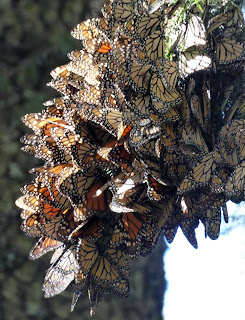After a month back at work, in both Panama and Honduras, I was able to take a few days off again for holiday, this time to Mexico. I'd never been to Mexico City before so took a couple of days to whizz round a few highlights of this city of 22 million people. It was crowded (and the sense of personal space is quite different, as people consistently bash into you as they walk past, making no effort to step a few inches to the side to avoid such collisions), it was polluted, and there was clear evidence of the subsidence the city is suffering from as the aquifer below is depleted of its water (see the angle of the chapel to the right of the cathedral in the photo above) - but it was still a city I felt comfortable in. There is so much grand old architecture that it looks like a European city. It is also bursting with museums and galleries, several of them world class.

I spent time at Frida Kahlo's old house and made two separate visits to the incredible National Anthropological Museum. I was headed out to Teotihuacán afterwards and they recommend a visit to this museum first, but really it is a place everyone should go, full of impressive exhibits from the various pre-Colombian civilisations such as the Aztecs, the Mayans and the Olmecs.
I didn't want to focus only on ancient cultures, however, so also had a wander around Tianguis del Chopo, a flea market for old (and new) punks and goths. Lots of stalls selling punk Tshirts and leather jackets, mixed in with lots of stuff using the skull motif that is so popular in Mexico. I wore an old (37-year-old!!!) Siouxsie & the Banshees Tshirt and an equally old skull-and-crossbones earring, but couldn't compete with some of the people there, like this guy to the right with his multi-coloured mohican!
But the time passed quickly and soon it was time to find the northern bus station, to head out to Teotihuacán to join the tour group from the UK who I'd be spending the next week with. I was already with a friend - an American guy I'd met in Guyana a couple of years ago - and we'd spent many hours in Mexico City discussing Trump and Brexit, thankfully sharing the same revulsion towards the illiberal, racist and xenophobic movements convulsing our two countries. So when I saw the Brits in the tour group - nearly all of retirement age and none from London - I warned him that we should probably steer clear of such conversations if we didn't want to get into arguments, given the demographics of the Brexit vote. But the subjects came up anyway - how you could you avoid discussing that wall when you are in Mexico?! - and I was pleasantly surprised to find we were all on the same page. I suppose because we were pre-selected as a group of people who travel, and who are interested in the wider world, so how could we hold such prejudices?
Of those people I know back in the UK, a disappointing number of them voted for Brexit, but all Brits I meet whilst travelling are more open to the world, thankfully. It does though make me wonder what I will encounter should I move back to the UK. Indeed it makes me ask myself the question sometimes whether I really want to move back there at all. But meeting with this group of British holidaymakers did give me some hope.
So, my friend and I went birding around the hotel area before the others arrived, and joined them in the morning for a tour of the ruins of Teoptihuacán. Sadly we were not doing the luxury hot air balloon version of the tour that is clearly popular:
but we did a walking tour, managing to pick up some nice birds along the way such as cactus wren and blue grosbeak, as well as spotted ground squirrel sitting on what looked to be a painful seat!












